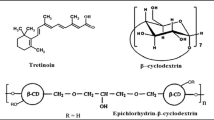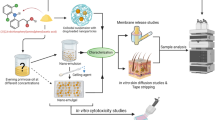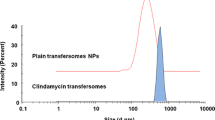Abstract
The objective of this investigation was to evaluate the effect of delivery strategies such as cyclodextrin complexation and liposomes on the topical delivery of ketorolac acid (KTRA) and ketorolac tromethamine. Ketorolac acid–hydroxypropyl-β-cyclodextrin solid dispersions (KTRA-CD) were prepared by kneading method. The liposomes containing ketorolac tromethamine (KTRM) and KTRA-CD were prepared. The in vitro permeation of KTRM solution, KTRA solution, KTRA-CD, and liposomes containing KTRM or KTRA-CD through guinea pig skin was evaluated. The anti-inflammatory activity of the topically applied KTRA-CD gel (containing 1% w/w KTRA) was compared to that of orally delivered KTRM solution. The KTRA-CD demonstrated significantly higher transdermal transport of ketorolac as compared to all other systems whereas liposomes significantly reduced the transport of ketorolac. The anti-inflammatory activity of the topically applied KTRA-CD gel was similar to that of the orally administered KTRM. Thus, cyclodextrin complexation enabled effective transdermal delivery of the ketorolac.


Similar content being viewed by others
References
M.M. Buckley, and R.N. Brogden. Ketorolac: a review of its pharmacodynamic and pharmacokinetic properties, and therapeutic potential. Drugs. 39:86–109 (1990).
J.R. DeAndrade, M. Maslanka, T. Maneatis, L. Bynum, and M. Burchmore. The use of ketorolac in the management of postoperative pain. Orthopedics. 17:157–166 (1994).
J.C. Gillis, and R.N. Brogden. Ketorolac: a reappraisal of its pharmacodynamic and pharmacokinetic properties and therapeutic use in pain management. Drugs. 53:139–188 (1997).
D.I. Reinhart. Minimizing the adverse effects of ketorolac. Drug Safety. 22:487–497 (2000).
Y.A. Cho, and H.S. Gwak. Transdermal delivery of ketorolac tromethamine: effects of vehicles and penetration enhancers. Drug Dev. Ind. Pharm. 30:557–564 (2004).
I.A. Alsarra, A.A. Bosela, S.M. Ahmed, and G.M. Mahrous. Proniosomes as a drug carrier for transdermal delivery of ketorolac. Eur. J. Pharm. Biopharm. 59:485–490 (2005).
B.Y. Kim, H.J. Doh, T.N. Le, W.J. Cho, C.S. Yong, H.G. Choi, J.S. Kim, C.H. Lee, and D.D. Kim. Ketorolac amide prodrugs for transdermal delivery: stability and in vitro rat skin permeation studies. Int. J. Pharm. 293:193–202 (2005).
K. Park, D. Verotta, S.K. Gupta, and L.B. Sheiner. Passive versus electrotransport-faciliated transdermal absorption of ketorolac. Clin. Pharmacol. Ther. 63:303–315 (1998).
S.B. Tiwari, and N. Udupa. Investigation into the potential of iontophoresis facilitated delivery of ketorolac. Int. J. Pharm. 260:93–103 (2003).
S.B. Tiwari, and R.M. Pai. Influence of ultrasound on the percutaneous absorption of ketorolac tromethamine in vitro across rat skin. Drug Deliv. 11:47–51 (2004).
M. Masson, T. Loftsson, G. Masson, and E. Stefansson. Cyclodextrins as permeation enhancers: some theoretical evaluations and in vitro testing. J. Control. Rel. 59:107–118 (1999).
T. Loftsson, and M. Masson. Cyclodextrins in topical drug formulations: theory and practice. Int. J. Pharm. 225:15–30 (2001).
M.M.A. Elsayed, O.Y. Abdallah, V.F. Naggar, and N.M. Khalafallah. Lipid vesicles for skin delivery of drugs: reviewing three decades of research. Int. J. Pharm. 332:1–16 (2007).
M.S. Nagarsenker, R.N. Meshram, and G. Ramprakash. Solid dispersion of hydroxypropyl β-cyclodextrin and ketorolac: enhancement of in-vitro dissolution rates, improvement in anti-inflammatory activity and reduction in ulcerogenicity in rats. J. Pharm. Pharmacol. 52:949–956 (2000).
C.A. Ventura, S. Tommasini, A. Falcone, I. Giannone, D. Paolino, V. Sdrafkakis, M.R. Mondello, and G. Puglisi. Influence of modified cyclodextrins on solubility and percutaneous absorption of celecoxib through human skin. Int. J. Pharm. 314:37–45 (2006).
F. Maestrelli, M.L. Gonzalez-Rodrıguez, A.M. Rabasco, and P. Mura. Preparation and characterisation of liposomes encapsulating ketoprofen-cyclodextrin complexes for transdermal drug delivery. Int. J. Pharm. 298:55–67 (2005).
Acknowledgements
Authors wish to thank Phospholipid GmBH (Germany), Cerestar (USA) and Sun Pharma (India) for the gift samples of Phospholipon 90 and 90H, HPBCD and ketorolac tromethamine, respectively.
Author information
Authors and Affiliations
Corresponding author
Rights and permissions
About this article
Cite this article
Nagarsenker, M.S., Amin, L. & Date, A.A. Potential of Cyclodextrin Complexation and Liposomes in Topical Delivery of Ketorolac: In Vitro and In Vivo Evaluation. AAPS PharmSciTech 9, 1165–1170 (2008). https://doi.org/10.1208/s12249-008-9157-2
Received:
Accepted:
Published:
Issue Date:
DOI: https://doi.org/10.1208/s12249-008-9157-2




